句子成分和句子结构-13页文档资料
- 格式:doc
- 大小:72.00 KB
- 文档页数:13
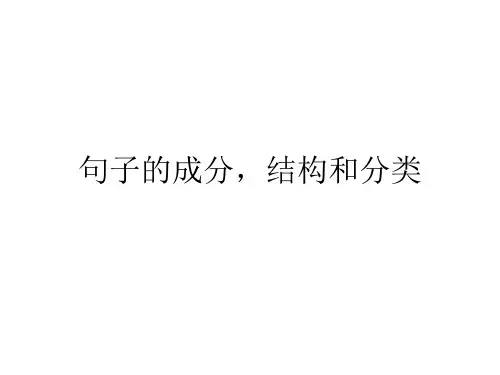
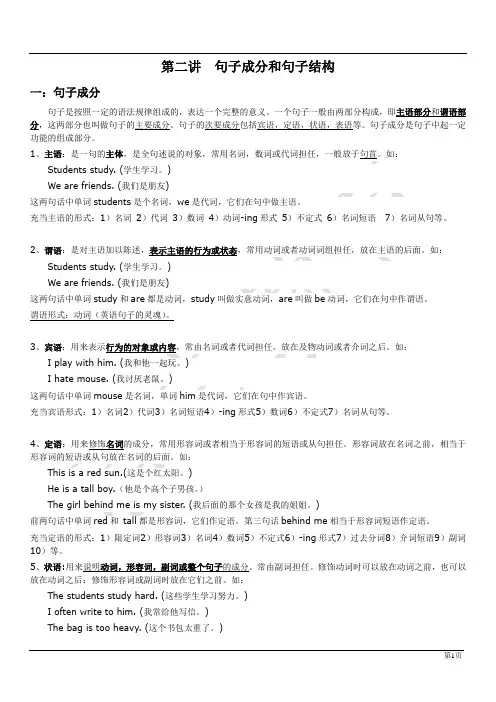
第二讲句子成分和句子结构一:句子成分句子是按照一定的语法规律组成的,表达一个完整的意义。
一个句子一般由两部分构成,即主语部分和谓语部分,这两部分也叫做句子的主要成分。
句子的次要成分包括宾语,定语,状语,表语等。
句子成分是句子中起一定功能的组成部分。
1、主语:是一句的主体,是全句述说的对象,常用名词,数词或代词担任,一般放于句首。
如:Students study. (学生学习。
)We are friends. (我们是朋友)这两句话中单词students是个名词,we是代词,它们在句中做主语。
充当主语的形式:1)名词2)代词3)数词4)动词-ing形式5)不定式6)名词短语7)名词从句等。
2、谓语:是对主语加以陈述,表示主语的行为或状态,常用动词或者动词词组担任,放在主语的后面。
如:Students study. (学生学习。
)We are friends. (我们是朋友)这两句话中单词study和are都是动词,study叫做实意动词,are叫做be动词,它们在句中作谓语。
谓语形式:动词(英语句子的灵魂)。
3、宾语:用来表示行为的对象或内容,常由名词或者代词担任。
放在及物动词或者介词之后。
如:I play with him. (我和他一起玩。
)I hate mouse. (我讨厌老鼠。
)这两句话中单词mouse是名词,单词him是代词,它们在句中作宾语。
充当宾语形式:1)名词2)代词3)名词短语4)-ing形式5)数词6)不定式7)名词从句等。
4、定语:用来修饰名词的成分,常用形容词或者相当于形容词的短语或从句担任。
形容词放在名词之前,相当于形容词的短语或从句放在名词的后面。
如:This is a red sun.(这是个红太阳。
)He is a tall boy.(他是个高个子男孩。
)The girl behind me is my sister. (我后面的那个女孩是我的姐姐。
)前两句话中单词red和tall都是形容词,它们作定语。
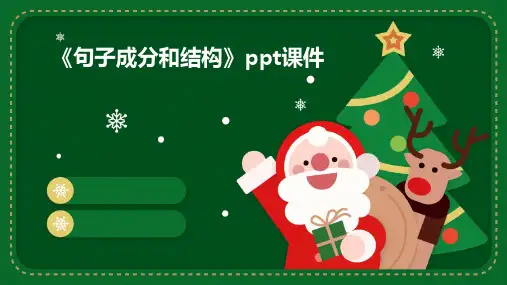
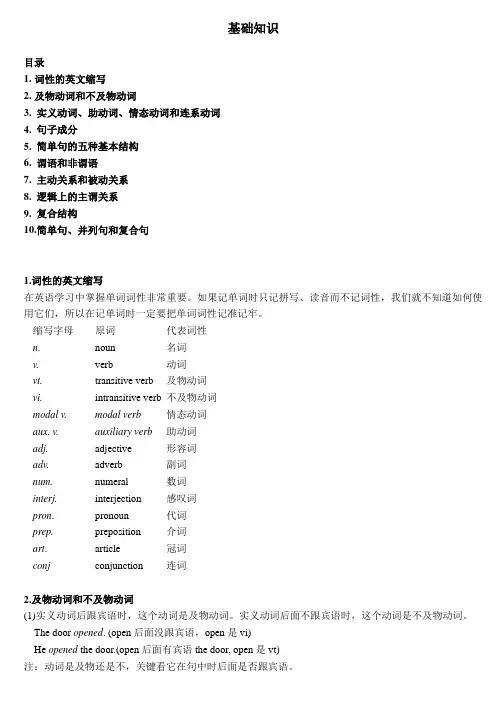
基础知识目录1.词性的英文缩写2.及物动词和不及物动词3. 实义动词、助动词、情态动词和连系动词4. 句子成分5. 简单句的五种基本结构6. 谓语和非谓语7. 主动关系和被动关系8. 逻辑上的主谓关系9. 复合结构10.简单句、并列句和复合句1.词性的英文缩写在英语学习中掌握单词词性非常重要。
如果记单词时只记拼写、读音而不记词性,我们就不知道如何使用它们,所以在记单词时一定要把单词词性记准记牢。
缩写字母原词代表词性n. noun 名词v. verb 动词vt.transitive verb 及物动词vi.intransitive verb 不及物动词modal v. modal verb 情态动词aux. v. auxiliary verb 助动词adj.adjective 形容词adv.adverb 副词num. numeral 数词interj. interjection 感叹词pron. pronoun 代词prep.preposition 介词art. article 冠词conj conjunction 连词2.及物动词和不及物动词(1)实义动词后跟宾语时,这个动词是及物动词。
实义动词后面不跟宾语时,这个动词是不及物动词。
The door opened. (open后面没跟宾语,open是vi)He opened the door.(open后面有宾语the door, open是vt)注:动词是及物还是不,关键看它在句中时后面是否跟宾语。
(2)有些动词既可作vt又可作vi,词义相同。
The meeting began at six. < vi.> We began the meeting at six. < vt.>(3)有些动词既可作vt又可作vi,但词义不同。
The man walked away. (walk vi,意为“走”)He walked the dog every day. ( walk vt,“遛”)She washes clothes at home. (wash vt,“洗”)The clothes washes well. (wash vi,“耐洗”)(4)英语中一些单词是及物还是不及物,可能与汉语不同。
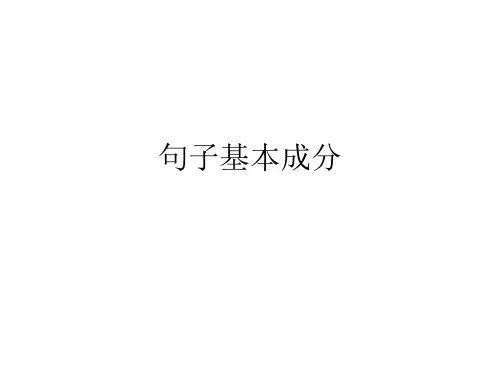
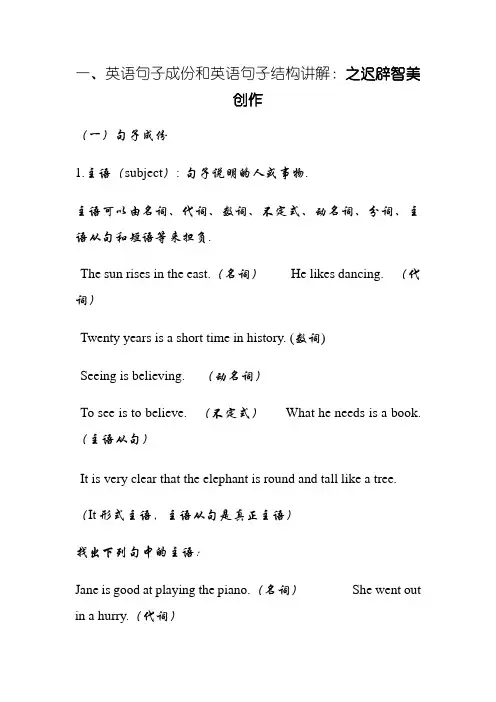
一、英语句子成份和英语句子结构讲解:之迟辟智美创作(一)句子成份1.主语(subject): 句子说明的人或事物.主语可以由名词、代词、数词、不定式、动名词、分词、主语从句和短语等来担负.The sun rises in the east.(名词)He likes dancing. (代词)Twenty years is a short time in history. (数词)Seeing is believing. (动名词)To see is to believe. (不定式)What he needs is a book. (主语从句)It is very clear that the elephant is round and tall like a tree.(It形式主语,主语从句是真正主语)找出下列句中的主语:Jane is good at playing the piano.(名词)She went out in a hurry.(代词)Four plus four is eight.(数词)To see is to believe.(不定式)Smoking is bad for health.(动名词)The young should respect the old.(名词化的形容词)What he has said is true. (句子)2.谓语(predicate): 说明主语的举措、状态和特征.简单谓语:由动词或动词词组组成I saw the flag on the top of the hill?He looked after two orphans.复合谓语:由情态动词或助动词+动词;He can speak English well.She doesn’t seem to like dancing.找出下列句中的谓语(注:只有动词才可作谓语.):1. We love China.2. We have finished reading this book.3. He can speak English.4. She seems tired.3.表语(predicative): 系动词之后的成份,暗示主语的性质、状态和特征.He is a teacher. (名词)Seventy-four! You don’t look it. (代词)Five and five is ten. (数词)He is asleep. (形容词)His father is in. (副词)The picture is on the wall. ( 介词短语)My watch is gone / missing / lost. (形容词化的分词)To w ear a flower is to say “I’m poor, I can’t buy a ring. (不定式)The question is whether they will come. (表语从句)★(罕见的系动词有: be, sound(听起来), look(看起来), feel(摸起来,smell(闻起来),taste(尝、吃起来), remain(坚持,仍是), feel(感觉) ... It sounds a good idea. The sound sounds strange. Her voice sounds sweet. Tom looks thin.The food smells delicious. The food tastes good.The door remains open. Now I feel tired.找出下列句中的表语.1. I am a teacher.2. They are on the playground.3. My job is teaching English.4. It gets cold.5. It sounds interesting.4.宾语:1)举措的接受者-----及物动词或介词的宾语I like China. (名词)He hates you. (代词)How many do you need? We need two. (数词)We should help the old and the poor. I enjoy working with you. (动名词)I hope to see you again. (不定式)Did you write down what he said? (宾语从句)2)介词后的名词、代词和动名词-----介宾Are you afraid of the snake? Under the snow, there are many rocks.3)双宾语-----间宾(指人)和直宾(指物)宾语分为直接宾语和间接宾语.直接宾语指物或事,间接宾语指人或植物.He gave me a book yesterday. Give the poor man somemoney.指出下面句子的间接宾语和直接宾语:please pass me the book.He bought his girlfriend some flowers.找出下列句子的宾语部份:1. We often help him.2. He likes to play basketball.3. We enjoy listening to the music.4. She said that he felt sick.5. They are talking about the new student.5.宾补:对宾语的弥补,全称为宾语补足语.有些及物动词除有一个直接宾语以外,还要有一个宾语补足语,说明宾语的身份和状态以弥补其意义缺乏,使句子的意义完整.这类经常使用的及物动词有:We elected him monitor. (名词)We all think it a pity that she didn’tcome here. (名)We will make them happy. (形容词)We found nobody in. ( 副词)Please make yourself at home. 介词短语)Don’t let him do that. (省to不定式)His father advised him to teach the lazy boy a lesson. (带to不定式)Don’t keep the lights burning. (现在分词)I’ll have my bike repaired. (过去分词)6.主补:对主语的弥补,全称为主语补足语.He was elected monitor. She was found singing in the next room.He was advised to teach the lazy boy a lesson.7.定语:修饰或限制名词或代词的词、词组或句子.Ai Yanling is a chemistry teacher.(名词)He is our friend. (代词)We belong to the third world. (数词)He was advised to teach the lazy boy a lesson.(形容词)The man over there is my old friend.(副词)The woman with a baby in her arms is my sister. (介词)The boys playing football are in Class 2. (现在分词)The trees planted last year are growing well now. (过去分词)I have an idea to do it well. (不定式)You should do everything that I do. (定语从句)定语后置:如果定语是由一个单词暗示时,通常要前置.而由一个词组或一个句子暗示时,通常则后置The girl in red is his sister.We have a lot of work to do.The girl standing under the tree is his daughter.Do you know the man who spoke just now?8.状语:用来修饰v., adj., adv., 或句子.暗示时间、地址、原因、结果、水平、条件、方式和让步. (以下例句按上述顺序排列)I will go there tomorrow.The meeting will be held in the meeting-room.The meat went bad because of the hot weather.He studies hard to learn English well.He didn’t stu dy hard so that he failed in the exam. I like some of you very much.If you study hard, you will pass the exam. He goes to school by bike.Though he is young, he can do it well.(二)句子结构简单句的五个基本句型1.主语+不及物动词She came./ My head aches.2.主语+及物动词+宾语She likes English.3.主语+系动词+表语She is happy.4.主语+双宾动词+间接宾语+直接宾语She gave John a book.5.主语+宾补动词+宾语+宾语补语She makes her mother angry.The teacher asked me to read the passage.★There +be 句型There are some books on the desk.There lies a book on the desk.Exercises :分析下列句子成份1. Our school is not far from my home.2. It is a great pleasure to talk with you3. All of us considered him honest.4. My grandfather bought me a pair of sports shoes.5. He broke a piece of glass.6. He made it clear that he would leave the city.翻译练习:主谓结构(主语+不及物动词)1、你应该努力学习You should study hard.2、他昨天晚上很晚回家She went home very late yesterday evening.练习:1、This box weighs five kilos. 这个盒子重五公斤.2、I lived in Beijing five years ago. 五年前我住在北京.主谓宾结构(主语+及物动词+宾语)1、我昨晚写了一封信I wrote a letter last night.2、我今天下午想和你谈谈I want to talk with you this afternoon.练习:1、All of us believe that Jack is an honest boy. 我们年夜家都相信Jack 是一个诚笃男孩.2、He did not know what to say. 他不知道说什麽好.主系表结构(主语+系动词+表语)1.我的弟弟都是年夜学生My brothers are all college students.2.在冬季,白天很短夜晚很长In winter, the days are short and the nights are long.3. 布朗女士看上去很健康Mrs Brown looks very healthy.4.在他15岁那年他成了著名的画家At the age of fifteen he became a famous pianist.练习:1、树叶已经变黄了.The leaves have turned yellow.2、这个陈说听起来很有意思.The report sounds interesting.双宾语结构(主语+双宾动词+间接宾语+直接宾语)1.强森先生去年叫我们德语Mr Johnson taught us German last year.2.祖父昨晚给我讲了一个有趣的故事Grandma told me an interesting story last night.练习:1、请你给我弄一本新的,好吗?Will you please get me a new copy?2、我替你叫辆出租汽车好吗?Shall I call you a taxi?复合宾语结构(主语+动词+宾语+宾语补足语)1.我们叫她爱丽丝We call her Alice.2.他父母叫他约翰His parents named him John.练习:1、学校定了一条规则,开始上课时学生要起立.The school made it a rule that the students should stand up when class begins.2、我认为与那个人谈话是无益的.I thought it no use talking with that manThere be 句型1.今晚不会开会There isn’t going to be a meeting tonight.2.这个村落里只有一口井There was only a well in the village.练习:1、铃响了.There goes the bell2、一周有七天.There are seven days a week二、英语句子种类讲解:依照句子的用途,英语句子可分为陈说句、疑问句、祈使句和感叹句.依照句子的结构,英语句子可分为简单句、并列句和复合句.中考对句子的考查主要集中在以下几个方面:1. 陈说句的构成形式及基本用法;2. 祈使句的构成形式及基本用法;3. 一般疑问句、特殊疑问句、选择疑问句、反意疑问句的构成形式及基本用法;4. 由what, how引导的感叹句的构成形式、用法及区别对各种从句的用法我们在后面分别论述.(一.) 陈说句的构成形式及基本用法1. 陈说句:陈说句是用来陈说一个事实或表达说话人看法(包括肯定和否定)的句子.通经常使用降调,句末用句号“.”. Tom has a new car.The flower isn’t beautiful.2. 陈说句否定式的构成(1) 如果肯定陈说句的谓语部份含有助动词、情态动词或连系动词be,则只需在这些动词后加not即可构成否定式.He is playing the guitar.(肯定)He is not playing the guitar.(否定)We can get there before dark.(肯定)We can’t get thee before dark.(否定)(2) 如果陈说句的谓语动词是实义动词,而其中又没有情态动词或助动词时,则需根据人称和时态在该实义动词前加don’t, doesn’t或didn’t.同时把该实义动词酿成原形.He plays the violin well.(肯定)He doesn’t play the violin well.(否定)She won the game.(肯定)She didn’t win the game.(否定)(3) 如果句子是there be结构或谓语动词是have(有),除be和have之后加not之外,句中如果有some要酿成any.例如:There is some water in the cup. →There is not any water in the cup.He has some books. →He has not any books.(4) 除not以外,否定词no, never, nothing, nobody, few等也可构成否定句.例如:There is something wrong with his bike. →There is nothing wrong with his bike.I have seen the film. →I have never seen the film.(二.) 祈使句的构成形式及基本用法祈使句是用来暗示命令、请求、建议、号召等的句子,谓语动词用原形,句末用感叹号“!”或句号“.”.朗读时一般用降调.1.肯定的祈使句:(1)祈使句主语是you时,you常省略,但如果要特别强调对方或表达某种强烈的情绪时可以有主语或称号语.Be quiet.You be quiet!(2)“Do+祈使句”暗示一种强烈的感情或请求,do起强调作用.Do come back at once! Do be careful.(3)please用在祈使句中可以暗示一种客气的语气,但please 用在句末时,必需用逗号与其余部份分开.Open the window, please.(4)Let引导祈使句时,后面需跟上人称代词或称号语,人称代词一般只用第一、第三人称.Let Jack wait a minute.Let’s go to school.(5)在祈使句中,Let’s和Let us是有区另外.Let’s包括说话者,而Let us不包括听话者在内.这点从反意疑问句时可明显看出.Let’s go skating, shall we?(暗示内部的建议)Let us try again, will you?(暗示向他人发出请求)2. 否定祈使句通常以Don’t或Never开头.其结构通常是:“Don’t(Never)+动词原形+其他成份” 例如:Don’t do that again!Never leave today’s work for tomorrow! Don’t be late next time!(三.) 一般疑问句、特殊疑问句、选择疑问句、反意疑问句的构成形式及基本用法1. 一般疑问句:(1)一般疑问句的肯定形式一般疑问句一般是指以助动词、情态动词、be动词或have (有)开始,通常要求以yes,或no来回答的疑问句,一般疑问句读时通经常使用升调.Do you know Mr. Smith Can you swim?(2)一般疑问句的否定结构①在一般疑问句的否定结构中,把副词not放在一般疑问句的主语之后.但如果用not的简略形式-n’t,则须将-n’t与一般疑问句句首的be, have,助动词或情态动词写在一起.在实际运用中,一般都采纳简略式.Are you not a football fan?Aren’t you a football fan?Will she not like it?Won’t she like it?②与汉语分歧的是,英语一般疑问句否定结构的答语是否定还是肯定,全由答语的否定或肯定来决定.若答语是肯定的,则用yes加肯定结构;若答语是否定的,则用no加否定结构.Aren’t you a football fan? 你不是足球迷吗?Yes, I am.\ No, I am not.Won’t she like it?Yes, she will. \ No, she won’t.。
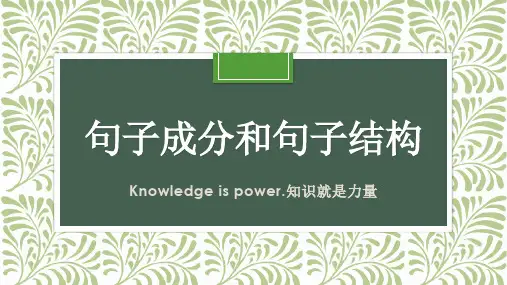
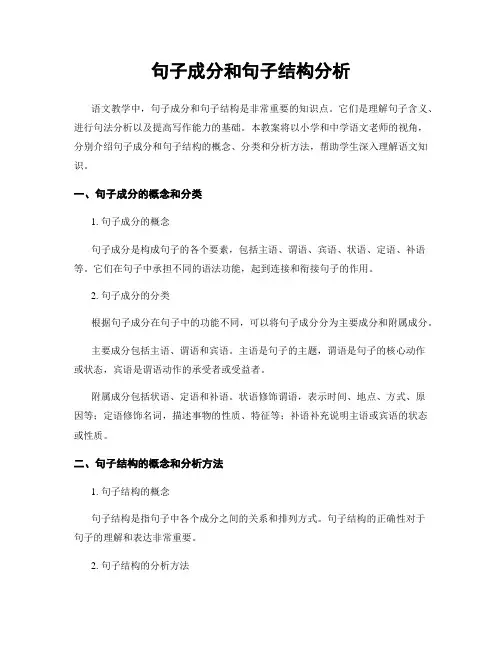
句子成分和句子结构分析语文教学中,句子成分和句子结构是非常重要的知识点。
它们是理解句子含义、进行句法分析以及提高写作能力的基础。
本教案将以小学和中学语文老师的视角,分别介绍句子成分和句子结构的概念、分类和分析方法,帮助学生深入理解语文知识。
一、句子成分的概念和分类1. 句子成分的概念句子成分是构成句子的各个要素,包括主语、谓语、宾语、状语、定语、补语等。
它们在句子中承担不同的语法功能,起到连接和衔接句子的作用。
2. 句子成分的分类根据句子成分在句子中的功能不同,可以将句子成分分为主要成分和附属成分。
主要成分包括主语、谓语和宾语。
主语是句子的主题,谓语是句子的核心动作或状态,宾语是谓语动作的承受者或受益者。
附属成分包括状语、定语和补语。
状语修饰谓语,表示时间、地点、方式、原因等;定语修饰名词,描述事物的性质、特征等;补语补充说明主语或宾语的状态或性质。
二、句子结构的概念和分析方法1. 句子结构的概念句子结构是指句子中各个成分之间的关系和排列方式。
句子结构的正确性对于句子的理解和表达非常重要。
2. 句子结构的分析方法句子结构的分析可以从两个方面进行:成分分析和句子类型分析。
成分分析是指对句子中各个成分的识别和分析。
通过观察句子中的主谓宾结构、状语和定语等成分,可以准确地判断句子的结构。
句子类型分析是指对句子的基本类型进行分类。
常见的句子类型包括陈述句、疑问句、祈使句和感叹句。
通过分析句子的语气和语序等特点,可以判断句子的类型。
三、句子成分和句子结构的分析实例下面通过几个实例来进行句子成分和句子结构的分析:1. "小明喜欢吃水果。
"这个句子的主要成分有主语"小明"、谓语"喜欢吃"和宾语"水果"。
附属成分中没有状语、定语或补语。
2. "昨天在公园里,我看到了一只漂亮的小鸟。
"这个句子的主要成分有主语"我"、谓语"看到"和宾语"一只漂亮的小鸟"。

英语句子成分和句子结构什么叫句子成分呢?句子的组成成分叫句子成分。
在句子中,词与词之间有一定的组合关系,按照不同的关系,可以把句子分为不同的组成成分。
句子成分由词或词组充当。
现代汉语里一般的句子成分有六种,即主语、谓语、宾语、定语、状语和补语。
英语的基本成分有七种:主语(subject)、谓语(predicate)、表语(predicati ve)、宾语(object)、补语(complement)、定语(attribute)和状语(adverbial)。
英语句子成分中,有些具有形态标志。
如第一人称代词作主语就用主格“I”,作宾语用宾格“me”,作定语用所有格“my”。
这些形态变化对分析辨认成分很有帮助。
把句子的各个成分搞清楚,也就是把句子各部分的关系搞清楚。
做到这一点,才可以准确地理解句子的意思或造出结构正确、意思明白的句子。
有一点要注意,在分析句子结构时,应该抓住主要成分。
我们分析句子结构,划分句子成分无非是为了理解,或者是为了造句。
这个目的达到了就行了,不必过于细致,更不要钻牛角尖,否则就会事倍功半。
各种语言有各自的规则、各自的习惯,而且语言是很灵活的东西,发展过程也很复杂,很难把语法的现象都做出明确、统一的解释来。
在使用一种语言时,语法应让位于习惯。
符合习惯的,有时尽管不符合语法,也是正确的。
英语句子有长有短,有简有繁,从现象看,似乎千变万化,难以捉摸,但从实质看,可以发现其内在联系,找出其共同规律。
英语句子的基本结构可以归纳成五种基本句型及其扩大、组合、省略或倒装。
掌握这五种基本句型,是掌握各种英语句子结构的基础。
一、句子结构:五种基本句型英语五种基本句型列式如下:基本句型一:SV(主+谓)基本句型二:SVP(主+谓+表)基本句型三:SVO(主+谓+宾)基本句型四:SVoO(主+谓+间宾+直宾)基本句型五:SVOC(主+谓+宾+宾补)注意区别句型四和句型五:We call it a cake.We give it a cake 小窍门:划线部分如果能用be动词连接,意思通顺的话,就是宾补结构,如果意思不通顺的话,就是双宾结构。
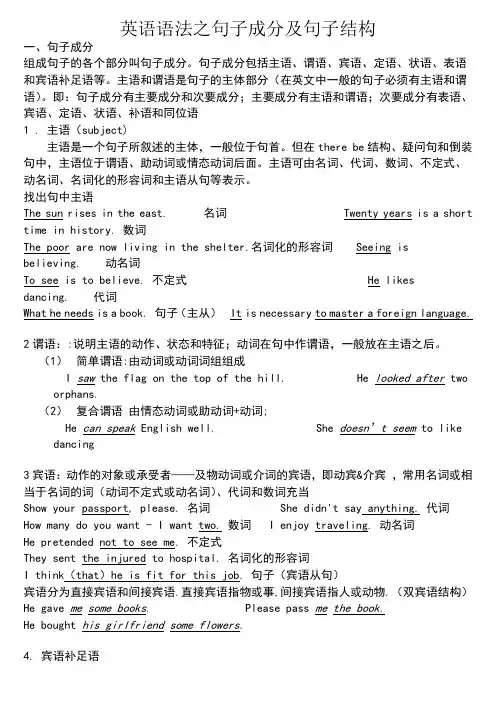
英语语法之句子成分及句子结构一、句子成分组成句子的各个部分叫句子成分。
句子成分包括主语、谓语、宾语、定语、状语、表语和宾语补足语等。
主语和谓语是句子的主体部分(在英文中一般的句子必须有主语和谓语)。
即:句子成分有主要成分和次要成分;主要成分有主语和谓语;次要成分有表语、宾语、定语、状语、补语和同位语1 . 主语(subject)主语是一个句子所叙述的主体,一般位于句首。
但在there be结构、疑问句和倒装句中,主语位于谓语、助动词或情态动词后面。
主语可由名词、代词、数词、不定式、动名词、名词化的形容词和主语从句等表示。
找出句中主语The sun rises in the east. 名词 Twenty years is a short time in history. 数词The poor are now living in the shelter.名词化的形容词 Seeing is believing. 动名词To see is to believe. 不定式 He likes dancing. 代词What he needs is a book. 句子(主从) It is necessary to master a foreign language.2谓语::说明主语的动作、状态和特征;动词在句中作谓语,一般放在主语之后。
(1)简单谓语:由动词或动词词组组成I saw the flag on the top of the hill. He looked after twoorphans.(2)复合谓语由情态动词或助动词+动词;He can speak English well. She doesn’t seem to like dancing3宾语:动作的对象或承受者——及物动词或介词的宾语,即动宾&介宾,常用名词或相当于名词的词(动词不定式或动名词)、代词和数词充当Show your passport, please. 名词 She didn't say anything. 代词How many do you want - I want two. 数词 I enjoy traveling. 动名词He pretended not to see me. 不定式They sent the injured to hospital. 名词化的形容词I think(that)he is fit for this job. 句子(宾语从句)宾语分为直接宾语和间接宾语.直接宾语指物或事,间接宾语指人或动物.(双宾语结构)He gave me some books. Please pass me the book.He bought his girlfriend some flowers.4. 宾语补足语有些及物动词除了有一个直接宾语以外,还要有一个宾语补足语,说明宾语的身份和状态以补充其意义不足,使句子的意义完整(宾语的复合结构)。
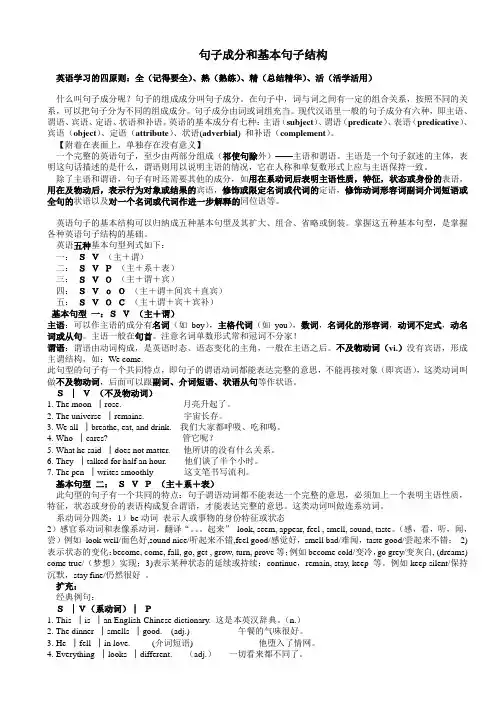
句子成分和基本句子结构英语学习的四原则:全(记得要全)、熟(熟练)、精(总结精华)、活(活学活用)什么叫句子成分呢?句子的组成成分叫句子成分。
在句子中,词与词之间有一定的组合关系,按照不同的关系,可以把句子分为不同的组成成分。
句子成分由词或词组充当。
现代汉语里一般的句子成分有六种,即主语、谓语、宾语、定语、状语和补语。
英语的基本成分有七种:主语(subject)、谓语(predicate)、表语(predicative)、宾语(object)、定语(attribute)、状语(adverbial) 和补语(complement)。
【附着在表面上,单独存在没有意义】一个完整的英语句子,至少由两部分组成(祁使句除外)——主语和谓语。
主语是一个句子叙述的主体,表明这句话描述的是什么,谓语则用以说明主语的情况,它在人称和单复数形式上应与主语保持一致。
除了主语和谓语,句子有时还需要其他的成分,如用在系动词后表明主语性质,特征,状态或身份的表语,用在及物动后,表示行为对象或结果的宾语,修饰或限定名词或代词的定语,修饰动词形容词副词介词短语或全句的状语以及对一个名词或代词作进一步解释的同位语等。
英语句子的基本结构可以归纳成五种基本句型及其扩大、组合、省略或倒装。
掌握这五种基本句型,是掌握各种英语句子结构的基础。
英语五种基本句型列式如下:一:SV(主+谓)二:SVP(主+系+表)三:SVO(主+谓+宾)四:SVoO(主+谓+间宾+直宾)五:SVOC(主+谓+宾+宾补)基本句型一:SV(主+谓)主语:可以作主语的成分有名词(如boy),主格代词(如you),数词,名词化的形容词,动词不定式,动名词或从句。
主语一般在句首。
注意名词单数形式常和冠词不分家!谓语:谓语由动词构成,是英语时态、语态变化的主角,一般在主语之后。
不及物动词(vi.)没有宾语,形成主谓结构,如:We come.此句型的句子有一个共同特点,即句子的谓语动词都能表达完整的意思,不能再接对象(即宾语),这类动词叫做不及物动词,后面可以跟副词、介词短语、状语从句等作状语。
英语句子成分及句子结构英语句子基本构成成分:主语:可以作主语的成分有名词如boy,主格代词如I ,we, he, she, they ,数词、动词不定式,动名词等;最常用的便是名词、代词、动名词、动词不定式;主语一般在句首;1名词作主语English is very important. 英语是很重要的;The students all love their English teacher. ‘这些学生都爱他们的英语老师;2代词作主语They go to school by bus. 他们乘公共汽车上学;3动名词作主语Watching TV too much is bad for your eyes.看电视太多对你的眼睛是有害的;It’s no use regretting it. 后悔是无用的;4动词不定式短语作主语To see is to believe. 眼见为实;It is necessary to master a foreign language.掌握一门外语是很必要的谓语:谓语由动词构成,谓语时态、语态的变化都体现在动词的变化上,一般在主语之后;1及物动词作谓语We should help each other. 我们应该互相帮助;All of the students like the novel. 所有这些学生都喜欢这本小说;2不及物动词作谓语You’re driving too fast. 你开车开得太快了;The teacher came in, book in hand. 老师走进教室,手里拿着书;3连系动词作谓语He looks worried.他看起来很担心;The box itself is not so heavy. 箱子本身并不重;4 复合谓语:①由情态动词加动词原形构成;如:You may keep the book for two weeks.②由助动词加动词原形,现在分词,过去分词构成;如:Do you speak EnglishThey are working in a field.He has caught a bad cold.注意:谓语与主语在人称与数方面要保持一致;宾语:宾语位于及物动词之后,一般同主语成分一样,不同的是构成宾语的代词必须是”代词宾格”如:me, us, him ,her ,themI like Chinese food. 我喜欢中国菜;I saw him yesterday. 代词昨天我看到他了;I enjoyed talking to you.我和你谈话很高兴;He wanted to have a cup of tea. 不定式短语他想要一杯茶;We hoped that you would stay for a few days.我们希望你能多待几天的;直接宾语和间接宾语——有些及物动词可以有两个宾语,一个指人,一个指物,指人的叫作间接宾语,指物的叫直接宾语;合称双宾;例如:He gave me some ink . 他给了我一些墨水;间接宾语直接宾语Our teacher told us an interesting story. 老师给我们讲了一个有趣的故事;间接宾语直接宾语表语:与连系动词连用,构成系表结构,说明主语的身份或特征,一般由形容词、名词、动名词、动词不定式、分词等充当;如:The flower is beautiful.They are brother and sister. 他们是兄妹;Her father is sixty-five. 她父亲65岁;The poor boy was myself.那个可怜的孩子就是我自己;All you need do is to take a taxi from the airport.你只需从机场打个的即可;My favourite sport is swimming. 我最喜爱的运动是游泳;定语:定语为句子的次要成分,起修饰限制名词或代词的作用,可分为前置定语和后置定语;一般由形容词性物主代词、数词、形容词、副词、介词短语、动词不定式、分词短语或句子充当;2 Mr. Green has two sons. 格林先生有两个儿子;数词3 The girl under the tree is Kate. 在树下的那个女孩是凯特;介词短语4 I bought a new dictionary. 我买了本新字典;5This is a green cup.这是一个绿色的杯子;形容词6The people here are very friendly.副词这里的人们非常友好;7 Would you like something to drink 你想要些喝的东西吗不定式8 A barking dog seldom bites. 吠狗很少咬人;V-ing9The suggestion sent to the committee was adopted. 过去分词送往委员会的建议被采纳了;10 Do you know the man who is standing next to Mr. Green 定从你认识站在格林先生旁边的那个人吗状语:状语修饰动词、形容词、副词或全句,说明时间、地点、方式、原因、条件、让步、方向、程度、目的等;状语在句子中的位置很灵活,常见情况为:通常在句子基本结构之后,强调时放在句首;修饰形容词或副词时,通常位于被修饰的词之前;地点状语一般须在时间状语之前;一些表示不确定时间如:often或程度如:almost的副词状语通常位于be动词、助动词、情态动词之后,动词之前;1 时间状语I often get up at 5:30 in the morning. 我常常在早上5:30起床;Hearing the news, they felt very excited.听到这个消息,他们感到很兴奋;2 地点状语Pandas only live in China. 熊猫仅生活在中国;3 程度状语4 目的状语We’ll go to the b each for a picnic this Sunday.这个星期天我们将去沙滩野炊;He took some change from his pocket to buy a newspaper.他从口袋里掏出一些零钱来买报纸;She got up early so that she could catch the first bus.她早早地起床,以便能够赶上这辆早班车;5 方式状语We usually go to school on foot. 我们通常步行去上学;Please do it as I told you. 请按我告诉你的去做;6 让步状语Though she has a lot of money, she is unhappy.虽然她很有钱,而她并不幸福;No matter what happens, I will never lose heart.无论发生什么,我将决不失去信心;7 条件状语If you don’t work hard, you’ll fall be hind the others.假如你不努力学习,你将落后于别人;Given more attention, the flowers would have grown better.如果给予更多的关心的话,这些花将长得更好;8 原因状语We didn’t go to the park because of the bad weather.由于天气不好,我们没有去公园;Because he was ill, he didn’t go to school.由于病了,他没有去上学;9 结果状语The wind was so strong that we could hardly move forward.风是如此地猛烈,以致于我们寸步难行;He left early, so that he caught the train.他早早地离去,结果因此赶上了火车;10 伴随状语The doctor hurried off, with a medicine box under his arm.这位医生匆匆离去,胳膊下夹着一个药箱子;The teacher came into the classroom, followed by a group of his students. 老师进到教室里来,后面跟着一群学生;补语:补语是起补充说明作用的成份;最常见的是宾语补足语;名词、动名词、形容词、副词、不定式、现在分词、过去分词都可以在句子中作宾补;1We call her Xiao L i. 名词宾语宾语补足语2You must keep the room clean and tidy. 形容词宾语宾语补足语3John asked me to help him with his Chinese. 动词不定式宾语宾语补足语4I will have my hair cut tomorrow. 过去分词宾语宾语补足语5We saw the boy playing basketball on the playground just n ow. v-ing宾语宾语补足语6 Rain makes plants grow.雨水使植物生长;动词原形宾语宾补注意: 后跟名词作宾语补足语的动词有call, name, think, make, choose 等,后跟形容词作宾语补足语的谓语动词有keep, find, get, think, make 等;动词不定式作宾语补足语时,当谓语动词为感官动词如feel, see, hear, notice, watch, observe, sound, 等,使役动词如let, have, make 等,动词不定式不带to;英语中的五种基本句型结构一、句型1:Subject 主语+Verb 谓语可以直接接宾语;常见的动词如:work, sing, swim, fish, jump,arrive, come, die, disappear, cry, happen等;5 The sun was shining. 太阳在照耀着;二、句型2:Subject 主语+Link. V系动词+Predicate表语这种句型主要用来表示主语的身份、特点等;其系动词一般可分为下列两类:1表示状态;这样的词有:be, lo ok, seem, smell, taste, sound, keep等;如:1 This kind of food tastes delicious.这种食物吃起来很可口;2 He looked worried just now.刚才他看上去有些焦急;春天到了,天气变得越来越暖和;2 The tree has grown much taller than before.这棵树比以前长得高多了;三、句型3:Subject主语+Verb 谓语+Object 宾语充当;例:当我遇到困难时,李雷总能给我帮助;她打算在即将到来的“五一”外出旅游;她喜欢看电视;我不知道下一步该干什么;注意:英语中的许多动词既是及物动词,又是不及物动词;四、句型4:Subject主语+Verb谓语+Indirect object间接宾语+Directobject 直接宾语这种句型中,直接宾语为主要宾语,表示动作是对谁做的或为谁做的,在句中不可或缺,常常由表示“物”的名词来充当;间接宾语也被称之为第二宾语,去掉之后,对整个句子的影响不大,多由指“人”的名词或代词承担;引导这类双宾语的常见动词有:buy, pass, lend, give, tell, teach, show, bring, send等;一本词典作为生日礼物;heroes in the Long March.老人经常给孩子们讲述长征途中那些英雄的故事;3Sandy gave the dog some food.桑迪给狗喂了些食物;上述句子还可以表达为:1Her father bought a dictionary for her as a birthday present.3Sandy gave some food to the dog.五、句型5:Subject主语+Verb 动词+Object 宾语+Complement补语此句型的句子的共同特点是:动词虽然是及物动词,但是只跟一个宾语还不能表达完整的意思,必须加上一个补充成分来补足宾语,才能使意思完整;宾语补足语:位于宾语之后对宾语作出说明的成分;宾语与其补足语有逻辑上的主谓关系,它们一起构成复合宾语;宾语补足语的主要作用或者是补充、说明宾语的特点、身份等;或者表示让宾语去完成的动作等;担任补语的常常是名词、形容词、副词、介词短语、分词、动词不定式等;如:1You should keep the room clean and tidy. 形容词你应该让屋子保持干净整洁;2 They painted the door green. 形容词他们把门漆成绿色;4 What makes him think so 动词原形他怎么会这样想他父亲告诉他不要在街上玩;7 I saw a cat running across the road. 现在分词我看见一只猫跑过了马路.昨天我跟两个美国人合了张影;形容词;It充当形式宾语,to learn English是真正的宾语;我发现学英语很难;简单句五种基本句型巧记歌诀:英语句子万万千,五大句型把线牵;句型种类看动词,后接成分是关键;系词之后接表语,不及物后无需连;及物又可分三类,单宾双宾最常见;还有宾语补足语,各种搭配记心间;Exercises:指出下列句子中划线部分的成分;1.We all study hard at English.A. 主语B. 谓语C. 宾语D.表语2.Betty likes her new bike very much.A. 主语B.谓语C.宾语D.表语3.My brother is a policeman.A. 主语B.谓语C.宾语D.表语4.Were you at home last nightA.定语B.状语C.宾补D.表语5.Winter is the coldest season of the year.A 定语 B.状语 C.宾补 D.表语6.He often walks in the park.A.定语B.状语C.宾语D.表语7.Mary asked me to help her yesterday.A.定语B.状语C.宾补D.表语8.He bought me a nice present last week.A.宾语B.直接宾语C.间接宾语D.宾补9.His parents are doctors.A.宾语B.表语C.谓语D.定语10.I’ll get you some tea now.A.宾语B.直接宾语C.间接宾语D.宾补11.My mother told us an interesting story last night.A.表语B.直接宾语C.间接宾语D.宾补12.He has read the book twice.A.主语B.谓语C.表语D.宾语13.They seemed unhappy when they heard the news.A.表语B.谓语C.宾语D.定语14.Do you have something to eatA.状语B.定语C.宾语D.宾补15.We made him our monitor.A.宾语B.定语C. 状语D.宾补Exercises:指出下列句子的基本类型1.They are listening.2.My mother is fifty now.3.I have bought three books.4.My friend gave me a birthday present.5.I painted the wall white.6.The boss often makes the workers work twelve hours a day.7.They arrived at six o’clock.8.The map is on the wall9.Children often sing this song.10.Mr Wu teaches us English.11.She showed her friends all her pictures.12.I find him a lovely boy.请朗读以下句子,划分下列句子的成分,并指出他们分别属于简单句中的哪种;1. Our country consumes a large number of plastic bags.2. The super-thin bags are the main source of white pollution.3. We should encourage people to return to carrying cloth bags.4. The new rule came out.5. Enviornmental groups welcome the new rule.6. They can stop using plastic bags.7. What is particularly positive is that it involves public participation.8. Shops don’t offer free plastic bags to their consumers.9. Hong Kong and Australia are considering measures to curb plastic bag litter.10. Chinese consumers have gotten used to free plastic shopping bags.。
句子结构与句子成分
句子结构是指句子的组成方式,包括主谓结构、主谓宾结构、主谓宾补结构、主谓双宾结构、主谓宾宾补结构、主谓状结构等。
句子成分是构成句子的基本要素,包括主语、谓语、宾语、补语、定语、状语和状语等。
主语:句子中表达动作或状态的中心,是句子的主要成分。
例如,"小明"是主语。
谓语:句子中表达动作或状态的关键,用来说明主语的动作、性质、状态等。
例如,"是"是谓语。
宾语:句子中被动作所直接作用的对象。
例如,"一名医生"是宾语。
补语:句子中用来补充说明主语或宾语的词或短语。
例如,"聪明"是主补,"到了三年级"是宾补。
定语:句子中用来修饰名词或代词的词或短语。
例如,"漂亮的花"中的"漂亮"就是定语。
状语:句子中用来修饰动词、形容词、副词或整个句子的词或短语。
例如,"昨天"是时间状语。
状语从句:用来修饰动词、形容词或副词的从句。
例如,"我希望他能来"中的"我希望"是主句,"他能来"是状语从句。
句子结构及成分一.句子成分现代汉语里一般的句子成分有六种,即主语、谓语、宾语、定语、状语和补语。
英语的基本成分有七种:除主语(subject)、谓语(predicate)、、宾语(object)、定语(attribute)、状语(adverbial) 和补语(complement)之外还有表语(predicative)(同位语)。
许国璋英语中划句子成分的符号主语在下面划一直线谓语在下面划曲线宾语在下面划双横线定语在下面划虚线(一行点使我们想到一排钉子,钉谐音为“定语” 的“定”)状语下面为短横线(短横线使我们想到短木桩,木桩撞(状)钟)补语上一短横,下一短横(下一短横好像是为了弥补上面短横间的空隙)同位语上下双曲线,(虽都有曲折,上下位置基本相同)1.主语主语是一个句子所叙述的主体,一般位于句首,通常由名词性的词来充当。
可由1。
名词、2.代词、3。
数词、4.名词化的形容词(如the rich)5。
不定式、6。
动名词、7。
主语从句等表示.The sun rises in the east.(名词)He likes dancing。
(代词)Twenty years is a short time in history。
(数词)Seeing is believing.(动名词)To see is to believe. (不定式)What he needs is a book. (主语从句)It is very clear that the elephant is round and tall like a tree. (It形式主语,主语从句是真正主语)练习1. 在下面句子的主语下面划横线,并说出由什么充当1.During the 1990s,American country music has become more and more popular。
2.We often speak English in class.3.One-third of the students in this class are girls。
句子成分和句子结构----认识英语句子的构成一、句子成分组成句子的各个部分叫做句子成分。
句子成分主要有主语、谓语、宾语、同位语、定语、状语、补足语、呼语和插入语等。
构成句子的主要部分是主语和谓语。
表语、宾语和补足语是谓语的组成部分。
其他成分如定语、状语、同位语是句子的次要成分。
1.主语主语是谓语动作或状态的执行者,指的是“谁”或“什么事”。
常用作主语的词类有:名词(短语)、代词、数词、名词化的形容词,不定式(短语)、动名词(短语)和从句。
George is a born leader. (名词)Nobody knew what had happened. (代词)Two of us will attend the conference tomorrow. (数词)The young are always willing to accept new things. (名词化的形容词)To go the bed early and to get up early is a good habit. (不定式短语)Losing his new MP4 made Tom very sad. (动名词短语)What we can’t get seems better than what we have. (名词性从句)2.谓语谓语用来描述主语的行为动作或所处的状态,说的是“做什么”或“怎么样”,谓语动词有人称、数、时态和语态等的变化。
Father cooks very well.My sister has worked in the company for five years.Our school is becoming more beautiful.The World Expo is well organized.3.宾语宾语是动作的承受者,指的是“做”的内容。
英语有单宾语、双宾语、复合宾语、同源宾语等。
双宾语又分为直接宾语和间接宾语。
凡能做主语的词、短语或从句都可以作宾语。
(1)单宾语(宾语)可以作宾语的成分主要有名词(短语)、代词、数词、名词化的形容词、名词化的分词、不定式(短语)、动名词(短语)、从句等。
I can hardly hear the radio. Would you please turn it up? (名词、代词)If you put 5 and 7 together, you’ll get 12, little Tom. (代词)We should help the poor. (名词化的形容词)Remember to tell him to come. (不定式)Please stop making noise. (动名词)Do you understand what I mean? (名词性从句)(2)双宾语双宾语指动词后面接指人和物的两个宾语。
指人的宾语叫间接宾语,指物的宾语叫直接宾语。
其结构为:主语+ 及物动词(短语)+ sb. + sth.Please tell me how the accident came about.The teacher asked me a question too difficult to answer.(3)同源宾语少数不及物动词后面能跟一个特定的名词作宾语,这个名词和前面的动词在词根上相同的或者在意义上是相近的,这样的宾语就叫做同源宾语。
同源宾语前面常有修饰语。
laugh a good laugh 大笑blow a heavy blow 沉重的一击smile a sweet smile 甜甜的微笑dream a terrible dream 做了一个恶梦die a brave death 死得英勇live a happy life 过着幸福的生活4.表语表语与前面的系动词一起构成谓语,用来说明主语的特征、类属、状态、身份等。
His father is an experienced teacher. (名词)She is over fifty, but she doesn’t look it. (名词、代词)These students are careful while others are careless. (形容词)The class meeting was over at last. (副词)Be quiet; they are at work now. (介词短语)His hobby is collecting foreign stamps. (动名词短语)My wish is to become a doctor in the future. (不定式短语)The news of her success is really exciting. (现在分词)(已形容词化)That is where your mistakes are. (名词性从句)5.定语定语是用来描述名词或代词的修饰语,它常和名词构成名词短语。
定语可分为前置定语和后置定语两种。
(1)前置定语可以充当前置定语的有形容词、代词、数词、名词和名词所有格、动词的-ing形式、动词的-ed形式等。
Many people have helped with (canned) food. (过去分词)Open (your) mouth and put out (your) tongue. (代词的所有格)She cut the cake into (two) pieces. (数词)I want to buy some (coffee) cups. (名词)Put the child in the (sleeping) bag. (动名词)You should adapt to the (changing) situation. (现在分词)(2)后置定语可以充当后置定语的有形容词,副词,介词短语,不定式(短语),动词的-ing短语,动词的-ed短语,从句等。
All people (present at the party) were his supporters. (形容词短语)I have got something (interesting) to tell every one of you. (形容词)The buildings (around) were badly damaged. (副词)The books (on the top shelf) were just bought. (介词短语)Let’s try another way (to do this). (不定式)There is a gentleman (asking to see you). (现在分词短语)Most of the people (invited to the party) were famous scientists. (过去分词)He lost his new pen (that was bought last week). (定语从句)6. 同位语在句中对某一成分作进一步的解释,说明,并且与其在语法上处于同等地位的句子成分叫做同位语。
同位语常放在被说明的名词或代词的后面,可以用作同位语的有名词,代词,数词和从句等。
The English Department has two foreign teachers, an Australian and an American. (名词) This term we each bought an e-dictionary. (代词)They three are all three-good students. (数词)The news that we are having a holiday is true. (同位语从句)7. 状语状语是用来修饰动词,形容词,副词或句子的一种句子成分。
它可以表示时间,地点,方式,程度,原因,目的,结果,条件和让步等关系。
可以充当状语的有副词,介词短语,不定式,分词,,形容词,名词和从句。
[At the news], the mother stood [there], [greatly surprised]. (介词短语、副词、形容词)They held the English party [in the open air]. (介词短语)Just wait [a moment]; I am dressing myself. (名词)[To hear more clearly], she sat in the front of the classroom. (不定式)[Finishing all her homework], she surfed the Internet for a while. (现在分词短语)[Seen from the top of the hill], the small city looks more beautiful. (过去分词短语)Don’t leave here [until you work out the math problem]. (时间状语从句)8. 补足语补足语用来说明宾语或主语的性质,状态等的一种句子成分。
名词,形容词,副词,介词短语,现在分词,过去分词,不定式等皆可以作补足语。
I saw nobody <in> so I left. (副词)You’d better keep the books <standing> on the desk. (现在分词)The mother didn’t allow her daughter <to go out> alone at night. (不定式)These things should be kept <in the box>. (介词短语)The coming exam keeps me <busy with my lessons>. (形容词短语)He was elected <chairman> of the company. (名词)When he arrived, he found all the people <gone>. (过去分词)9. 独立成分与句子没有关系或关系不大,独立于句子之外的成分称为独立成分。
感叹词,呼语和插入语是英语中常见的三种独立成分。
(1)感叹词感叹词作独立成分多置于句首。
Well, let’s end the discussion!There, there! Never mind. It’s nothing serious at all.(2) 呼语呼语多独立成分可置于句首,句中或句末。